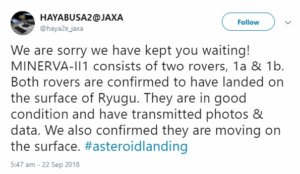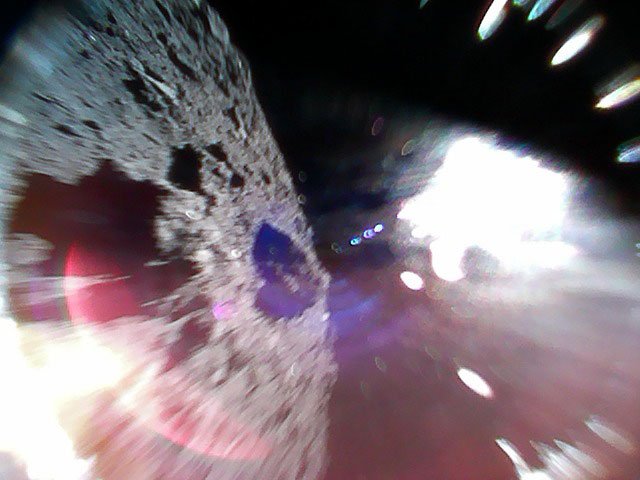Japanese spacecraft Hayabusa2 was launched from Earth back in November 2014, backpacking on a H-IIA rocket, in an attempt to arrive in the vicinity of Ryugu, a near-Earth asteroid that orbits the sun every 16 months.
Though the spacecraft barely got any attention from the western world, Hayabusa2 kept going, keeping its mission in focus and, on Friday, it deployed two miniature rovers (MINERVA-II1A and MINERVA-II1B), bound for the surface of Ryugu.
The Hayabusa Twitter account did everything in their power to keep everyone updated in real time as the events took place:

The Hayabusa2 spacecraft takes a photo of its shadow as it falls onto Ryugu’s surface in order to deploy the MINERVA rovers
Initially, the communication with the two rovers stopped near touchdown time, and it took over 24 hours for the Japanese Space Agency to provide an update on their fate – the two little things seem to be doing well, and they marked the world’s very first attempt (and success) of landing on a moving asteroid.

Not only did they land safely, but the rovers also sent a couple of amazing photos down to Earth.

Photo taken by Rover-1B on Sept 21 at ~13:07 JST. It was captured just after separation from the spacecraft. Ryugu’s surface is in the lower right. The misty top left region is due to the reflection of sunlight. 1B seems to rotate slowly after separation, minimising image blur.

This dynamic photo was captured by Rover-1A on September 22 at around 11:44 JST. It was taken on Ryugu’s surface during a hop. The left-half is the surface of Ryugu, while the white region on the right is due to sunlight. (Hayabusa2 Project)
The rovers will be used to conduct more research on the origins of the solar system. Because the asteroid has a low gravity, the rovers will basically be jumping around to heights of up to 15 meters (49 feet) and be able to stay in the air for as long as 15 minutes. This will give them the opportunity to survey the asteroid’s physical features.
But it does not stop here – the Hayabusa2 will deploy what JAXA calls an ‘impactor‘ which will explode above the asteroid and shoot out copper missile weighing 2kg, that will create a small crater into the surface. From the crater, materials will be collected which have not been exposed to wind and radiation and hopefully, with them on their hands, the scientists will be able to uncover more of the mysteries that surround life, the universe and whether space elements have contributed to life on Earth.
The Hayabusa is set to return to Earth with the samples in 2020 and we hope to hear about more adventures and discoveries from it until then.
Follow TechTheLead on Google News to get the news first.























